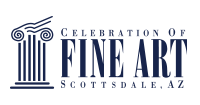Troy Moody first discovered fine art glass in his late teens. Over the years his glass techniques have evolved and grown to include a repertoire of stained glass, kiln-formed glass, and mixed media collage.
He recently began collaborating with his mother, Maxine, a longtime watercolor artist. Maxine paints works on her art board and Troy creates fused glass pieces to sit atop her painting.
Troy discusses his process and how his art has evolved over the years. Maxine also contributes to the interview! See the Q&A below or watch the full video interview that follows.
How has your art evolved?
Even when I was a kid and in high school, I was drawing a lot –– it was mostly pen and ink. I was really focused on line and contour and gestures. By the time I found glass, I was in my late teens, early 20s, and that was very traditional stained glass –– medieval techniques that haven’t changed in close to a thousand years. Then sometime in the mid to late 90s, I got involved in kiln-formed glass, which was a more contemporary look, more spontaneous.
Over the last 25 years, while the focus has always been glass, more and more I’m combining it with mixed media. So I’m able to bring in this practice that I had earlier in my life of drawing and painting and collage, and creating a story or a composition that way, but then imposing over that the fused glass, which is a whole new language for me.
Speaking of new techniques…what’s new with your work this year?
My mother has been painting my whole life. So, once I started developing this recipe of doing the fused glass mounted over the mixed media, it was only logical that one day we would come to the idea that she could do watercolors on the cradled art board that could accommodate my fused glass.
Maxine: He said, “Mom, why don’t you do some of your paintings on the cradle board? And then I can put my creativity with my fused glass on top.” It’s a fun relationship.
What is most challenging about your process?
Glass as a medium definitely presents its own challenges. There’s logistics and parameters that I work within because there are certain things glass just won’t do. So, that is a unique challenge to working with glass, particularly.
Aside from that, there’s not a lot of challenges when I’m actually creating the work. When I’m able to get into the studio, clear my head, get the right space, and just plug in –– or plug out, whatever it is –– then it happens naturally.
What makes the Celebration of Fine Art unique?
There’s a lot that makes the Celebration unique. I think probably the most noteworthy results from the fact that we’re here for 10 weeks. The artists get to know each other; we develop a camaraderie. We can get helpful critiques and advice from each other.
Another side of that same camaraderie is that we get to know the patrons. A lot of the visitors will come through multiple times throughout the season. So, I think those are two really significant, unique aspects of the Celebration.
And having that extra time here, not only does it build camaraderie, but it allows the artists the time to explore their craft and push the boundaries. You can watch the work evolve over the 10 weeks.
Maxine: I love the family that Susan has created with the Celebration. I feel like everybody is my kid because I’m so old, I could be everybody’s mother! I feel like they’re all family, and you care about them.

